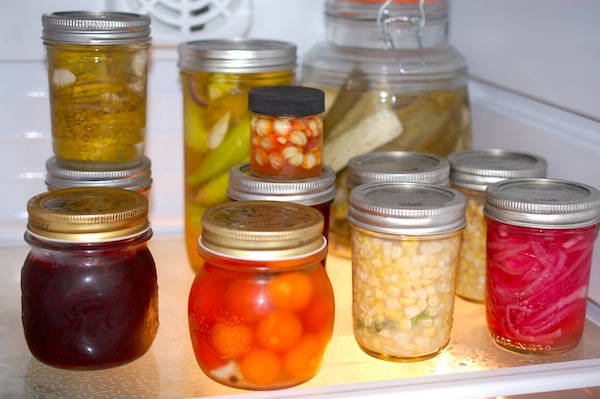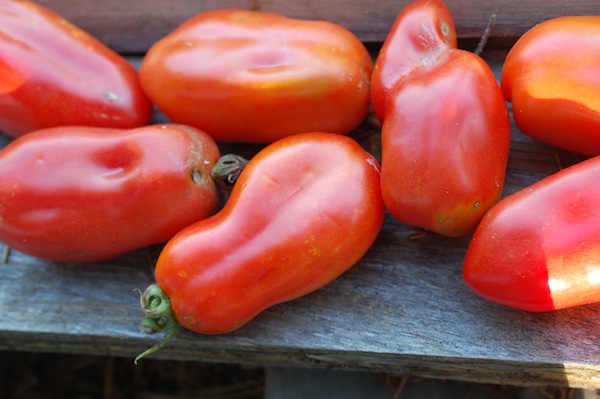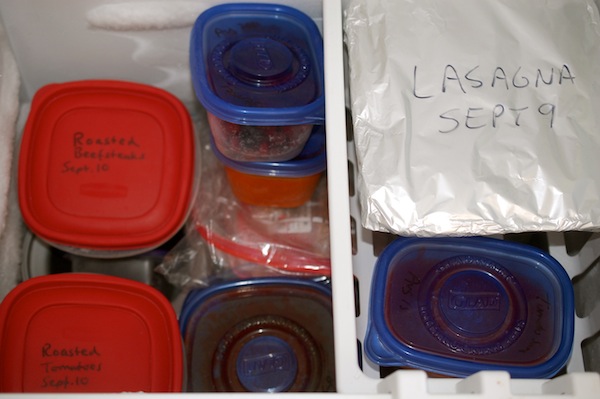 Until I moved to West Tisbury, the agricultural center of Martha’s Vineyard (that translates to small, rural town with many farms), I didn’t fully understand the origin of the expression “Making hay while the sun shines.”
Until I moved to West Tisbury, the agricultural center of Martha’s Vineyard (that translates to small, rural town with many farms), I didn’t fully understand the origin of the expression “Making hay while the sun shines.”
Now that I am surrounded by hay fields, I’ve learned to note the passing of warm weather months according to whether it’s the first, second or sometimes even the third haying. The grass grows tall and down it goes. Cut, dried, rowed, and baled. It grows again and so on.
And I’ve also come to understand that rain and wet weather can ruin hay, so farmers look for a spell of sunny, dry weather to do the haying. Basically, they’re taking advantage of a window of opportunity.
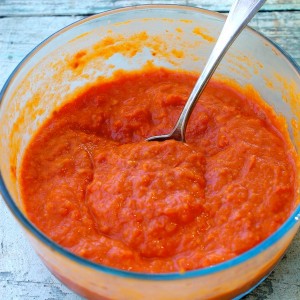 It seems like there’s a lot of that proverbial “making hay while the sun shines” on a farm. For me this year it has been all about trying to do something with extra vegetables before they cross the line into compost. The race against time is especially frustrating because there is so very little spare time to begin with on a farm! (Well, especially a growing farm with only two people working on it.) The hours in between the morning and evening chores are when Roy and I try to get our other work done, while keeping an eye on the farm stand, too. (September is quieter, yes, but we’ve already sold out of eggs (30 dozen) today, so it isn’t that quiet!)
It seems like there’s a lot of that proverbial “making hay while the sun shines” on a farm. For me this year it has been all about trying to do something with extra vegetables before they cross the line into compost. The race against time is especially frustrating because there is so very little spare time to begin with on a farm! (Well, especially a growing farm with only two people working on it.) The hours in between the morning and evening chores are when Roy and I try to get our other work done, while keeping an eye on the farm stand, too. (September is quieter, yes, but we’ve already sold out of eggs (30 dozen) today, so it isn’t that quiet!)
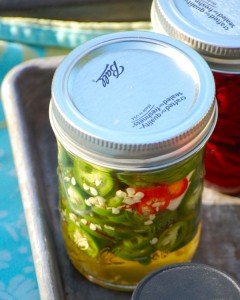 Fortunately I got a magazine assignment to write about pickling, so I’ve been able to justify spending some of those in-between hours making pickles. The top shelf of the mud-room fridge is now Ball-jar central. And I did make blackberry jam.
Fortunately I got a magazine assignment to write about pickling, so I’ve been able to justify spending some of those in-between hours making pickles. The top shelf of the mud-room fridge is now Ball-jar central. And I did make blackberry jam.
But my hopes that this would finally be the year I’d be canning lots of tomatoes and tomato sauce were a bit unrealistic. (Though we do have a stack of quart Ball jars we keep hopefully tripping over, thinking they may still get used.) For one thing, I didn’t realize that the San Marzano tomato plants were indeterminate—meaning that they yield continuously. I thought they were determinate, and I imagined that at some point they would offer up a big batch of ripe plum tomatoes, and we would then stop everything and spend an afternoon canning. Ha! Turns out they’ve been continuously ripening since mid-August, so they must get dealt with periodically (and a few dozen or so at a time).
Secondly, after a great early yield, our beefsteak and plum tomatoes all began to suffer from disease brought on by stress. (It took us a while to figure out that a pressure valve in our irrigation system was malfunctioning.) As a result, most of the tomatoes (including the San Marzanos) have been developing small rot spots as they get close to ripening. Since we can’t sell damaged tomatoes, I’ve had to think of something to do with them once or twice a week, since many are perfectly fine for the most part.
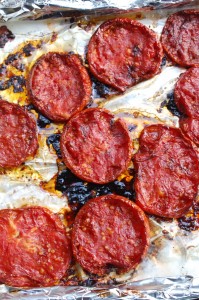 For any beefsteaks that aren’t too far gone, I’ve relied on my favorite technique. (Roasting, of course, but slow-roasting for these big guys.) Layered into containers, they freeze well for adding a great depth of flavor to just about anything in the winter months.
For any beefsteaks that aren’t too far gone, I’ve relied on my favorite technique. (Roasting, of course, but slow-roasting for these big guys.) Layered into containers, they freeze well for adding a great depth of flavor to just about anything in the winter months.
But for the San Marzanos, which still seem to be producing like crazy, I’ve been making small batches (a few quarts) of sauce for the freezer, which isn’t such a bad thing. (The freezer’s looking pretty promising, and I’m much happier with loads of tomato sauce rather than loads of pork like last year!)
Making sauce so frequently has also let me perfect a tasty recipe that is easy to get started quickly so that I can do other things while it simmers away on the stove.
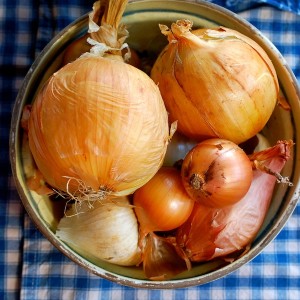 Here’s what I do: I chunk up a couple of our onions and several of our damaged carrots (which I have a lot of, too) and whiz them in the food processor. (I learned in my first restaurant cooking job how wonderful a generous amount of carrots can be in tomato recipes.) I melt butter (inspired by a Marcella Hazan recipe, I’ve switched from olive oil to butter in my sauce) in a big pot and sweat the veggies (salted of course) until they are soft. Meanwhile I mince several cloves of garlic and add that to the softened veggies. I sometimes add a splash of balsamic vinegar or a few red pepper flakes at this point.
Here’s what I do: I chunk up a couple of our onions and several of our damaged carrots (which I have a lot of, too) and whiz them in the food processor. (I learned in my first restaurant cooking job how wonderful a generous amount of carrots can be in tomato recipes.) I melt butter (inspired by a Marcella Hazan recipe, I’ve switched from olive oil to butter in my sauce) in a big pot and sweat the veggies (salted of course) until they are soft. Meanwhile I mince several cloves of garlic and add that to the softened veggies. I sometimes add a splash of balsamic vinegar or a few red pepper flakes at this point.
Then I usually wind up taking the pot off the stove for a few minutes while I finish cutting up the tomatoes. But I don’t fuss over the tomatoes. In fact, I don’t peel or seed them—I just cut out any spots and roughly chop everything else. I add a bit more butter to the pot, add all of the tomatoes and bring to a simmer. (Usually the pot is full almost all the way up to the top.) I let the sauce bubble very gently on low heat and reduce by about half (until I like the consistency), usually between 2 and 3 hours. I stir when I walk by, of course.
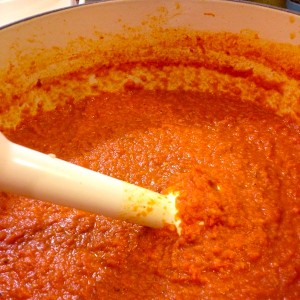 After I take the stove off the pot, I let it cool a bit and then use my immersion blender to roughly puree it so that the remaining bits of skin won’t be bothersome to anyone. Then I portion into different sized containers, let cool some more, and refrigerate or freeze. Not rocket science, I know, but it is satisfying. And at least I don’t have to wring my hands over dumping beautiful tomatoes in the compost pile.
After I take the stove off the pot, I let it cool a bit and then use my immersion blender to roughly puree it so that the remaining bits of skin won’t be bothersome to anyone. Then I portion into different sized containers, let cool some more, and refrigerate or freeze. Not rocket science, I know, but it is satisfying. And at least I don’t have to wring my hands over dumping beautiful tomatoes in the compost pile.

